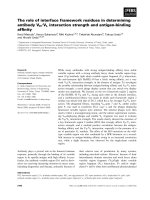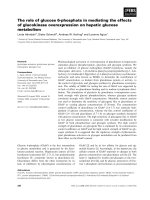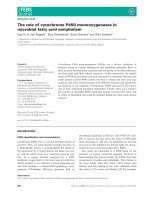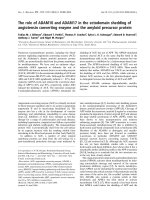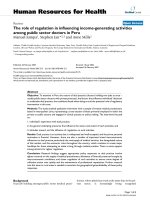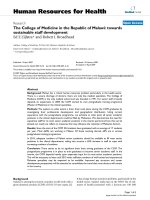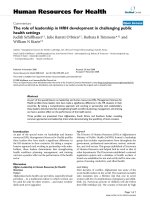báo cáo sinh học:" The role of nurses and midwives in polio eradication and measles control activities: a survey in Sudan and Zambia" pdf
Bạn đang xem bản rút gọn của tài liệu. Xem và tải ngay bản đầy đủ của tài liệu tại đây (221.5 KB, 8 trang )
BioMed Central
Page 1 of 8
(page number not for citation purposes)
Human Resources for Health
Open Access
Research
The role of nurses and midwives in polio eradication and measles
control activities: a survey in Sudan and Zambia
Annette Mwansa Nkowane*
1
, Liliane Boualam
2
, Salah Haithami
3
, El
Tayeb Ahmed El Sayed
4
and Helen Mutambo
5
Address:
1
Department of Human Resources for Health, World Health Organization, Geneva, Switzerland,
2
Polio Eradication Initiative, World
Health Organization, Geneva, Switzerland,
3
World Health Organization Country Office, Khartoum, Sudan,
4
Federal Ministry of Health,
Khartoum, Sudan and
5
World Health Organization Country Office, Lusaka, Zambia
Email: Annette Mwansa Nkowane* - ; Liliane Boualam - ;
Salah Haithami - ; El Tayeb Ahmed El Sayed - ;
Helen Mutambo -
* Corresponding author
Abstract
Background: Nurses and midwives are the key providers of nursing and midwifery services; in many countries, they
form the major category of frontline workers who provide both preventive and curative services in the community.
When the skills and experience of nursing and midwifery personnel are maximized, they can contribute significantly to
positive health outcomes. We conducted a survey among nurses and midwives working at district level in Sudan and
Zambia to determine their roles and functions in polio eradication and measles elimination programmes.
Methods: Nurses and midwives practising in four selected districts in Sudan and in Zambia completed a self-
administered questionnaire on their roles and responsibilities, their routine activities and their functions during
supplementary immunization campaigns for polio and measles.
Results: Nurses and midwives were found to play significant roles in implementing immunization programme activities.
The level of responsibilities of nurses and midwives in their routine work related more to existing opportunities than to
their job descriptions.
In Zambia, where nurses reported constraints in performing their tasks, the reasons cited were an increase in the burden
of disease and the shortage of health personnel. Factors identified as key to improving work performance included
written job descriptions, opportunities for staff and career development and opportunities to earn extra income through
activities associated with their jobs.
Other non-monetary incentives mentioned included reliable transport, resources and logistics to support routine work
in the district. However, in both countries, during supplementary immunization activities or mass campaigns for polio
eradication and measles control, nurses and midwives took on more management responsibilities.
Conclusion: This study shows that nurses and midwives play an important role in implementing immunization activities
at the district level and that their roles can be maximized by creating opportunities that lead to their having more
responsibilities in their work and in particular, their involvement in early phases of planning of priority health activities.
This should be accompanied by written job descriptions, tasks and clear lines of authority as well as good supportive
supervision. The lessons from supplementary immunization activities, where the roles of nurses and midwives are
maximized, can be easily adopted to benefit the rest of the health services provided at district level.
Published: 8 September 2009
Human Resources for Health 2009, 7:78 doi:10.1186/1478-4491-7-78
Received: 30 October 2008
Accepted: 8 September 2009
This article is available from: />© 2009 Nkowane et al; licensee BioMed Central Ltd.
This is an Open Access article distributed under the terms of the Creative Commons Attribution License ( />),
which permits unrestricted use, distribution, and reproduction in any medium, provided the original work is properly cited.
Human Resources for Health 2009, 7:78 />Page 2 of 8
(page number not for citation purposes)
Background
Human resources are crucial to effective delivery of health
services. Strategies across countries are, however, con-
strained by patchy evidence, limited planning tools and a
scarcity of technical expertise [1].
Nursing and midwifery services are a subsystem of health
services that are provided by a wide range of personnel.
These services share common attributes such as: preven-
tion of diseases; caring for, supporting and comforting cli-
ents; continuously assessing and monitoring health needs
and responses to interventions; advocacy and education
of clients and communities; and delivering and coordinat-
ing health services across the care spectrum [2]. Nurses
and midwives are the key health care providers and con-
stitute the largest proportion of the health workforce glo-
bally. In most countries, they are the first, and often the
only, point of contact for patients, and in many rural areas
they often provide as much as 80% of required health care
services [3].
Barriers to the delivery of primary health care interven-
tions include lack of prescribing authority, lack of support
from physicians, reimbursement difficulties and lack of
public awareness [4]. Recent global initiatives such as
polio eradication and measles elimination have led to the
recognition that roles of nurses and midwives can be max-
imized and that they form a key human resource in activ-
ities that require mass community mobilization and
involvement.
These lessons can be used to improve the delivery of other
health services in many resource-constrained settings.
This paper reports on a survey conducted in Sudan and
Zambia in 2007, which looked at the roles of nurses and
midwives in the expanded programme on immunization.
Study objectives
The objectives of this study were to document the roles,
functions and contribution of nurses and midwives in the
delivery of routine immunization services and supple-
mentary immunization activities for disease prevention,
control or eradication and to identify the best practices
that can be adopted for use in other priority health pro-
grammes.
Study justification
One of the key strategies for addressing the current human
resources crises in many countries is to maximize the roles
of existing human resources for health. For nurses and
midwives, who are core providers of health care services,
changes in how their work is structured and in their per-
ception of themselves can enable them to improve their
contribution to the health system. Facilitating nurses to
function at this level is necessary for the process of
empowerment [5].
Given the pace of change in health systems across the
world, the need to develop nurses and midwives who
value creativity and innovation and enjoy the challenge of
constant change has never been greater. Today's nurses
need to be comfortable with reorganization of their roles
and work patterns and to regard problem solving rather
than problem identification as essentially the norm of
operations [6].
Methods
Study sites
Two countries, Sudan and Zambia, participated in the
study. These countries were selected because they had pro-
grammes for routine immunization for children
(Expanded Programme on Immunization); had con-
ducted supplementary immunization campaigns for
polio eradication in the previous three years; had con-
ducted supplementary immunization campaigns for mea-
sles in the last three to four years; and had an established
surveillance system for vaccine-preventable diseases. In
each participating country, a purposeful convenient sam-
ple of four districts was selected; in each district, four
health facilities (two urban and two rural) were selected to
participate in the survey.
Study participants
In each district, two groups of health personnel were
invited to participate in the survey. These were (1) the dis-
trict EPI programme manager (or the equivalent person
with overall responsibility for EPI and supplementary
immunization activities (SIAs) for polio and measles) and
(2) all nurses and midwives working on immunization/
child health activities at health facilities in the participat-
ing district. Participation in the survey was voluntary and
the study was conducted in August and September 2007.
Study variables, data collection and data analysis
Structured, self-administered questionnaires were com-
pleted by the study participants. Both closed and open-
ended questions were used. The information from the two
groups of participants of the surveys fell into the following
broad categories: (1) general information on EPI and sup-
plementary vaccination activities in the district; (2) over-
all numbers and categories of health workers in the
district; (3) the role of nurses and midwives in EPI and
supplementary vaccination activities for polio and mea-
sles; (4) perceptions of nurses and midwives on how their
role can be maximized or enhanced in EPI, supplemen-
tary vaccination activities and other priority health issues
at district level; and (5) best practices and lessons learnt
from EPI and supplementary immunization activities for
Human Resources for Health 2009, 7:78 />Page 3 of 8
(page number not for citation purposes)
disease eradication or control. The findings from the sur-
vey were descriptively summarized.
Limitations of the study
The study is descriptive in nature and although compari-
sons can be made between the two countries that partici-
pated, standardized statistical testing and weighting of
results could not be applied.
Results
Survey of district EPI managers
Eight district EPI managers, one from each district, partic-
ipated in the survey. All the selected districts had con-
ducted SIAs for polio eradication and measles in 2006 and
2007. The district managers in Zambia were nurse-mid-
wives, while in Sudan they included nurses, midwives,
medical doctors and environmental health officers. In
both countries, the managers had been involved in EPI
programme activities for an average of five years.
All the districts had functioning routine EPI programmes
and the vaccine delivery strategies included fixed sites
(where vaccines are provided at the health facility), out-
reach (where the health workers provide vaccine in the
community at regular intervals), mobile delivery (where
health workers move from place to place providing vacci-
nations) and campaigns. All districts had a DTP3 coverage
(an indicator for routine immunization services) in the
last two years of more than 75%, and in all the supple-
mentary vaccination activities for both polio and measles,
coverage achieved was more than 90% of the target popu-
lation.
In both countries, the district managers were involved in
all aspects of immunization programmes, including SIAs.
These included planning, implementation, supervision of
staff and evaluation of programme activities. In Sudan,
the district managers reported that only 50% of the nurses
were involved in all the seven functions during SIAs (man-
agement, planning, advocacy, social mobilization, train-
ing, implementation, supervision, monitoring and
evaluation) and the same proportion was involved in AFP
surveillance. On the other hand, in Zambia, nurses and
midwives were involved in the full range of functions for
SIAs and AFP surveillance.
Survey of nurses and midwives working at health facilities
Routine tasks and service conditions of nurses and midwives
Forty-eight nurses and midwives participated in the sur-
vey. Twenty-six were from Sudan and 22 from Zambia.
The proportion of midwives was 30.1% and 68.2%,
respectively. The responses of the participants are pre-
sented in Table 1. A substantial proportion (38.5%) in
Sudan and the majority in Zambia (63.6%) were aware of
their written job descriptions. A higher proportion
(92.3%) in Sudan, compared with 68.2% in Zambia,
reported that the tasks they performed were consistent
with their written or perceived job descriptions.
Whereas 80.8% of the nurses in Sudan reported that the
tasks in their routine work were performed in a profes-
sional manner and matched their skills, in Zambia this
proportion was only 36.4%. The reason most commonly
cited by the nurses in Zambia was that they spent more
time dealing with diseases related to HIV infection,
including HIV counselling - including prevention of
mother to child transmission - referral of patients and
administrative tasks. Furthermore, there was more delega-
tion of tasks to other personnel in Zambia.
Supervision in both countries was reported as regular:
Sudan (76.9%), Zambia (72.7%). Whereas all respond-
ents in Sudan had received supervision in the three
months prior to the study, the proportion in Zambia was
only 31.8%. As regards supplies, logistics and salaries,
including benefits, these were considered adequate:
34.6%, 23.1%, 23.1%, respectively, in Sudan, but by a
much lower proportion in Zambia (18.2%, 9.1%, 9.1%).
Lastly, in Sudan, 92.3% reported they had regular in-serv-
ice training and 73.1% said they had career advancement
prospects in their jobs. In Zambia, the proportions were
lower (63.6% and 31.8%).
Factors perceived as improving work performance
Factors that were considered important to improving
work performance are listed in Table 2. In Sudan, these
were raising salaries (69.2%) and transport (57.7%).
Other factors named by 34.6% respondents were training,
good working environment and security and written job
descriptions. In Zambia, the two factors cited most were
transport (40.9%) and more staff (22.7%), whereas fac-
tors such as salaries including benefits and good working
environment were named by only 18.2% of the respond-
ents. Reported job-related incentives are shown in Table 3.
Overall, bonuses, job-related reimbursements and official
transport were cited by 42.3%, 30.1% and 30.1%, respec-
tively, by the nurses in Sudan, while in Zambia, overtime
(50.0%), bonuses (22.7%) and accommodation (18.2%)
were cited most.
Nurse-midwives' involvement in activities related to SIAs for polio and
measles
Roles of nurses and midwives in SIAs for polio and measles
The involvement of the nurses and midwives in activities
related to polio and measles SIAs is presented in Table 4.
In general, the levels of involvement in some of the tasks
differed between the two countries. In Sudan, manage-
ment and leadership functions were reported by a small
proportion for both polio and measles SIAs (23.1%). In
Zambia, this was much higher (90.9% and 72.7% respec-
Human Resources for Health 2009, 7:78 />Page 4 of 8
(page number not for citation purposes)
tively). This finding is related to the fact that most nurses
working at the health facility level in Zambia served in the
capacity of district managers of health programmes. The
finding that the nurses in Sudan were less involved in
planning of activities (15.2% in polio and in measles)
compared to 72.7% for polio and 90.9% for measles in
Zambia, is also a reflection of the management functions.
On the other hand, advocacy, social mobilization, train-
ing implementation and supervision were reported in
much higher proportions by nurses from both countries.
Monitoring and evaluation for polio and measles SIAs
were much lower in Sudan (11.5%, 11.5%) compared to
95.5% and 100.0% in Zambia.
Factors perceived as good for improving work performance during
polio and measles SIAs
Table 5 lists factors and incentives cited by the respond-
ents as conducive to good performance during SIAs for
polio and measles. In Sudan, free, good-quality transport
(84.6%), increased monetary incentives (73.1%), supervi-
sion during SIAs (69.2%), social mobilization (65.4%),
good planning (61.5%), training (61.5%) and commu-
nity participation (42.3% were the incentives most com-
monly cited. In Zambia the incentives most cited by the
nurses were: provision of meals (86.4%); protective mate-
rials when giving injections (86.4%); free, good-quality
transport (81.8%); adequate supplies (77.3%); social
mobilization (63.6%); more qualified staff (59.1%);
good planning (40.9%); and increased monetary incen-
tives (40.9%).
Barriers to good performance during SIAs for polio and measles
The factors reported to be important barriers hindering
good performance during immunization activities are
listed in Table 6. In Sudan, the factors most commonly
named were transport (50.0%), population illiteracy
(34.6%), weak community involvement (34.6%), nega-
tive community perceptions (26.9%) and mobile popula-
tions (26.9%). In Zambia, the barriers were weak
community involvement (59.1%), negative perceptions
of community towards immunizations (54.6%), trans-
Table 1: Profile of respondents, routine tasks and service conditions
Variable Sudan (n = 26) Zambia (n = 22)
Number % Number %
1 Professional category
• Nurse/Midwife 8 30.1 15 68.2
• Nurse 18 69.2 7 31.8
2 Respondent aware of written job description 10 38.5 14 63.6
3 Task consistent with job description 24 92.3 15 68.2
4 Tasks performed in a professional manner 21 80.8 8 36.4
5 Tasks match skills 21 80.8 8 36.4
6 Tasks take up too much time 13 50.0 17 77.3
7 Tasks delegated to others 2 7.7 18 81.8
8 Supervision:
• Regularly 20 76.9 16 72.7
• Last 3 months 20 76.9 7 31.8
9 Adequacy of supplies 9 34.6 4 18.2
10 Transport and logistics considered adequate 6 23.1 2 9.1
11 Salaries and benefits considered adequate 6 23.1 2 9.1
12 In-service training provided to staff 24 92.3 14 63.6
13 Career advancement prospects available 19 73.1 7 31.8
Human Resources for Health 2009, 7:78 />Page 5 of 8
(page number not for citation purposes)
port (31.8%), lack of supplies (31.8%) and wide distances
to cover (27.3%)
Lessons learnt from SIAs for polio and measles for improving work
performance and optimizing their role
The main lessons learnt from supplementary vaccination
campaigns for polio and measles control cited by the
respondents that can be used to improve the work of a
nurse or midwife were: understanding the community
needs, including mapping (Sudan 65.4%); the impor-
tance of supervision (Sudan 53.8%); importance of good
planning (Zambia 31.8%); and social mobilization and
community participation (Zambia 22.7%). Salaries were
cited by only 26.9% and 18.1% in Sudan and Zambia,
respectively, as an important factor for improving work
performance.
Best practices in SIAs for polio and measles
Nurses and midwives reported that they played a leading
role in the implementation of supplementary immuniza-
tion activities at the district level. When they served as dis-
trict managers, they did all the planning and budgeting for
activities. In addition, for the polio programme, nurses
and midwives coordinated advocacy meetings at the dis-
trict level and also organized sensitization meetings and
workshops for the community. Other programme activi-
ties in which nurses played a significant role included
social mobilization, training and serving as supervisors
for other health workers in the district.
Discussion
This case study on nurses and midwives working at district
level and at health facilities in Sudan and Zambia pro-
Table 2: Factors perceived to improve work performance
Factor Sudan (n = 26) Zambia (n = 22)
Number (%) Number (%)
1 Better supplies/logistics 1 3.8 2 9.1
2 Training 9 34.6 3 13.6
3 Salary increase 18 69.2 4 18.2
4 Good environment/
Security
9 34.6 4 18.2
5 Written job description 9 34.6 - -
6 Transport 15 57.7 9 40.9
7 More incentives 4 15.4 4 18.2
8More staff 522.7
Table 3: Reported job-related incentives
Income source Sudan (n = 26) Zambia (n = 22)
Number (%) Number (%)
1 Bonuses 11 42.3 5 22.7
2 Job related reimbursements 8 30.1 - -
3 Official transport 8 30.1 2 9.1
4 Accommodation provided 1 3.8 4 18.2
5 Hardship allowance 2 7.7 3 13.6
6 Overtime - - 11 50.0
Human Resources for Health 2009, 7:78 />Page 6 of 8
(page number not for citation purposes)
Table 4: Roles of nurses and midwives in polio and measles SIAs
Sudan (n = 26) Zambia (n = 22)
Variable Polio SIAs Measles SIAs Polio SIAs Measles SIAs
1 Management/leadership 6 (23.1%) 6 (23.1%) 20 (90.9%) 16 (72.7%)
2 Planning campaigns activities 4 (15.2%) 4 (15.2%) 16 (72.7%) 20 (90.9%)
3 Advocacy/co-ordination 19 (73.1%) 19 (73.1%0) 19 (86.4%) 19 (86.4%)
4 Social Mobilization 21 (80.8%) 21 (80.8%) 19 (86.4%) 20 (90.9%)
5 Training 18 (69.2%) 17 (65.4%) 20 (90.9%) 20 (90.9%)
6 Implementation 25 (96.2%) 26 (100.0%) 20 (90.9%) 20 (90.9%)
7 Supervision of staff 25 (96.2%) 26 (100.0%) 20 (90.9%) 20 (90.9%)
8 Monitoring & Evaluation 3 (11.5%) 3 (11.5%) 21 (95.5%) 22 (100.0%)
Table 5: Factors and incentives for good performance during SIAs for polio and measles
Incentive/factor Sudan (n = 26) Zambia (n = 22)
Number (%) Number (%)
1 Free good quality transport 22 84.6 18 81.8
2 Provision of meals during campaigns - - 19 86.4
3 Increased monetary incentives during campaign 19 73.1 9 40.9
4 Training 17 65.4 1 4.5
5 Protective material - - 19 86.4
6 Supervision during SIAs 18 69.2 2 9.1
7 Community leader involvement 8 30.1 2 9.1
8 Social mobilization 17 65.4 14 63.6
9 Good planning 16 61.5 9 40.9
10 Training 16 61.5 8 36.4
11 Adequate supplies 1 3.8 17 77.3
12 More qualified staff - - 13 59.1
13 Community participation 11 42.3 1 4.5
Human Resources for Health 2009, 7:78 />Page 7 of 8
(page number not for citation purposes)
vides valuable insight into the roles of nursing and mid-
wifery personnel in a priority public health programme
area. The finding that nurses and midwives in Zambia
have more responsibilities than were observed in Sudan
may be related to the organizational structure and nature
of personnel in the district. In Zambia, the managers at
the district are nurses and midwives.
Whatever the situation, however, in both countries nurses
and midwives are able to perform all the functions for the
programmes. The differences in responsibilities seem to
be related more to opportunities available for nurses to
take on management functions. This is reflected in the
finding that during SIAs, except for management func-
tions, the other functions are performed in similar pro-
portions in both countries.
Delegation of responsibilities to others appears to be
related to the management structure in place and possibly
the level of training. In both countries, the nurses and
midwives felt that the tasks they performed were consist-
ent with their job description. However, the finding that
only 38.5% in Sudan and 63.6% in Zambia reported
being aware of their written job descriptions for their rou-
tine work was of concern. Studies show that job descrip-
tions in addition to professional norms and codes of
conduct influence personnel performance.
The World health report of 2006 suggested that there is
need for proper matching of skills to the tasks at hand,
supported by supervision. It appears, in the case of Zam-
bia, that an increase in the burden of one disease, mainly
HIV-related care, takes up much of the nursing person-
nel's time. Nurses were not performing the tasks related to
their job descriptions and only 36.4% indicated that the
tasks matched their skills and job descriptions.
Job descriptions that have clear objectives, responsibili-
ties, authority and lines of accountability have been asso-
ciated with improved attainment of work goals for all
categories of health workers. Health worker motivation
cannot be expected to be high in a situation where other
tasks take up too much time.
The SIAs for polio eradication and measles control have
provided an opportunity for nurses and midwives to take
on more responsibilities. This in itself is a motivator and
consequently leads to better job performance, especially
when the tasks are clear and opportunities exist for per-
forming management tasks during SIAs [7]. In order to
perform the tasks well, working conditions are important.
This study shows that while in Sudan, the work conditions
were more or less favourable, in Zambia supplies, trans-
port and salaries were considered inadequate and a con-
straint. In both countries, written job descriptions,
opportunities for staff development and opportunities to
earn extra income associated with their jobs were consid-
ered crucial to improving work performance.
The roles and functions of nurses and midwives during
SIAs for polio and measles in both countries probably are
the best example of how their roles can be maximized in
programme implementation. Admittedly, SIAs for polio
require the commitment of personnel for defined periods.
However, the experience with participation in these activ-
ities and the roles played by nurses and midwives could be
adopted in their routine work.
Table 6: Barriers to good performance during SIAs for polio and measles
Sudan (n = 26) Zambia (n = 22)
Factors Number (%) Number (%)
1 Mobile populations 7 26.9 - -
2 Weather 5 19.2 - -
3 Wide coverage area (distance) 6 23.1 6 27.3
4 Population illiteracy 9 34.6 2 9.1
5 Negative perceptions of community towards immunizations 7 26.9 12 54.6
6 Transport problems 13 50.0 7 31.8
7 Weak community involvement 9 34.6 13 59.1
8 Lack of supplies 1 3.8 7 31.8
Publish with Bio Med Central and every
scientist can read your work free of charge
"BioMed Central will be the most significant development for
disseminating the results of biomedical research in our lifetime."
Sir Paul Nurse, Cancer Research UK
Your research papers will be:
available free of charge to the entire biomedical community
peer reviewed and published immediately upon acceptance
cited in PubMed and archived on PubMed Central
yours — you keep the copyright
Submit your manuscript here:
/>BioMedcentral
Human Resources for Health 2009, 7:78 />Page 8 of 8
(page number not for citation purposes)
Important factors identified by the nurses and midwives
that were crucial for improvement of performance are all
the well-known factors such as good, effective supervision
at all levels; planning of activities with community
involvement; and proper training of persons involved in
programme implementation. For supplementary activi-
ties, in contrast to routine activities, the barriers to imple-
mentation that were named tended to be non-human
resources related (such as community involvement, ade-
quate transport for operations and negative perceptions of
the community to interventions related to immuniza-
tions.
The key lessons learnt from participation in supplemen-
tary vaccination activities for polio eradication and mea-
sles control include the importance of good planning,
understanding community needs, good social mobiliza-
tion and supervision during implementation. All
throughout, good and reliable transport seems to be an
important incentive or factor for improving performance.
Conclusion
In summary, this study shows that nurses and midwives
play an important role in implementation of routine and
supplementary immunization activities at the district
level. Their roles can be maximized by creating opportu-
nities that lead to giving them more responsibilities, in
particular their involvement in early phases of planning of
priority health activities. This must, however, be accompa-
nied by written job descriptions, tasks and clear lines of
authority as well as good supervision. The lessons from
supplementary immunization activities, where the roles
of nurses and midwives are maximized, can be easily
adopted to benefit the rest of the health services that are
provided at district level.
Competing interests
The authors declare that they have no competing interests.
Authors' contributions
AMN conceptualized the project and wrote the study pro-
posal, designed the questionnaires and initiated and par-
ticipated in discussions, data analysis and writing of the
article. LB participated in the conceptualization of the
project, design of the study proposal, discussions, data
analysis and review of the article. SH, ETAES and HM were
involved in data collection, discussion and review of arti-
cle. All authors have read and approved the final manu-
script.
Acknowledgements
The assistance of the following is acknowledged for their technical support:
Fariba al Darazi, Helmy Mohammed Wahdan, Christopher Maher and Jean
Yan.
References
1. World Health Organization: World Health Report. Working
Together for Health. Geneva 2006.
2. World Health Organization: Nursing and Midwifery Services.
Strategic Directions 2002-2008. Geneva 2002.
3. Guest Editorial: Distance learning - meeting Africa's need for
quality nursing care. International Nursing Review 2006, 53:1.
4. Nkowane AM, Saxena S: Opportunities for an improved role for
nurses in psychoactive substance use: Review of literature.
International Journal of Nursing Practice 2004, 10:102-110.
5. Hajbaghery MA, Salsali M: A model for empowerment of nursing
in Iran. BMC Health Services Research 2005, 5:24.
6. Pearson A: Living with constant change in health care. Interna-
tional Journal of Nursing Practice 2006, 12:247.
7. Aylward RB, Linkins J: Polio eradication: mobilizing the human
resources. Bulletin of the World Health Organization 2005,
83:268-273.
